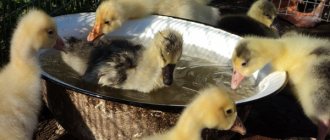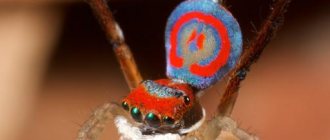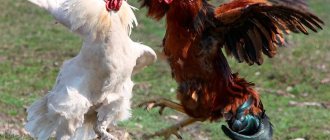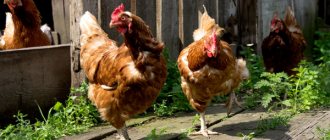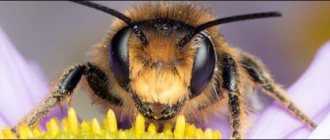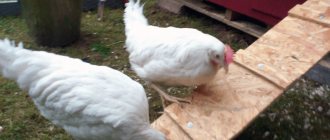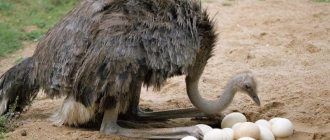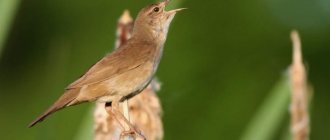What does a rooster look like?
Initially, you need to understand that each rooster looks different. However, characteristic features are still present in appearance. The first is bright plumage, although it varies among all individuals, even within the same species, it is certainly bright.
The second is the tail. They are long and fluffy, and the color of the tail is as colorful as the whole body. The head of this bird is decorated with a crest, popularly called a crest. Its color may vary, but in most cases it has a red tint. The beak is small, but sharp and slightly curved towards the bottom. Under the beak and on the sides of it, the rooster has fleshy flaps called a beard.
These birds have quite long, relative to their height, and strong legs with three toes and a spur on the back of the paws, which they use for defensive purposes. The number of fingers varies among different species. A rooster can hardly be called a small bird, since adults are capable of growing up to 30-50 centimeters in length, and reaching a weight in the average range of 2-4 kilograms.
Rooster photo
Cochin
Rooster breeds: description and photos
The Vietnamese breed is very similar in appearance to Brahma chickens. Due to low productivity, it is almost not used for breeding in Europe and Russia.
But at the end of the 19th century there was a whole fashion for these birds in European countries. There is no standard color for the breed; they have white, red, and fawn leading colors. On farms and breeding plants you can find various colors of Cochins.
The body is massive with a small head. The uniqueness of the appearance is given by the feathering on the paws, such peculiar “pants”.
The live weight of Cochin reaches 3.5–4 kg. They lay 100 to 120 eggs per year. It is noteworthy that the southern breed grows easily and lays eggs at fairly low temperatures. For this reason, in pre-revolutionary Russia it was quite popular among chicken breeders.
The birds are calm, sometimes even phlegmatic, prone to obesity, good hens take care of the chickens. Cochins are very expensive. Perhaps this explains their small numbers on European farmsteads and farms.
2
Differences between females and males
In these birds, there are many differences between female and male individuals. Externally, these birds can be distinguished by gender by the following differences:
- Appearance. Females have simpler and more modest colors, which most often have one shade. Chickens have a less pronounced comb and beard;
- Size. Chickens are significantly smaller than their feathered companions, both in weight and height. The difference in weight can reach two kilograms;
- Behavior. Roosters are much more aggressive than hens. During the mating season, fights often occur between roosters, in which one of the birds may well die.
Huge record breaking chickens
Many chicken farm owners try to achieve certain goals when breeding laying hens and even compete with each other. Some poultry farmers go even further - they try to make history by raising the largest chicken. Among them are Jeremy Goldsmith and the Stone family from the UK, Ronald Alldridge from Australia.
Ten-kilogram Big Snow
A Whitesulli rooster named Big Snow, owned by Australian Ronald Alldridge, set a weight record in 1992. He gained more than 10 kg with a height of 43 cm. Having measured the chest circumference of the bird, the commission recorded the figure - 84 cm. The farmer loved his pet very much and was proud of him, but, unfortunately, he soon died.
Little John
A huge Brahma rooster, Little John, lives in England. At the age of one, his height reached 66 cm. The owner of the giant, farmer Jeremy Goldsmith, does not want to reveal the secret of what he feeds his feathered friend, but admits that a special diet contributes to accelerated growth.
Rooster Coburn
This rooster is also English and belongs to the Brahma chicken breed. The bird's owners, the Stone couple, describe him as the brave head of the family. According to them, Rooster is not even afraid of foxes, which often enter the farm. This is not surprising, the rooster is 91 cm tall and weighs 11 kg.
Where do they live?
These birds can be found almost anywhere in the world, as they are completely domesticated birds. Although in theory it is possible for them to live in the wild, provided there is a warm climate. However, they cannot survive in nature for two reasons:
- Roosters cannot tolerate cold weather, and most likely will not be able to survive their first winter in the wild;
- These are not flying birds, which means that in the wild they become easily accessible prey for all predators.
A larger number of the total population live on industrial farms. Another small part is from private breeders in households. And the smallest part is found in houses. It is possible to keep decorative roosters at home.
These birds are distinguished by their unpretentiousness to living conditions. To carry out their own life activities, they only need minimal living conditions. Some species live their entire lives in cages, while for others they build chicken coops, where these birds create small nests for themselves.
Video
Eleventh place
Our rating continues with a truly natural wonder. We are talking about Bald Israeli chickens, specially bred by Professor Avigdor Kohaner. The professor explained his research by saying that in the Israeli heat, chickens don’t need plumage at all, and after 25 years of vigorous activity, he managed to “turn off” the unnecessary gene. Of course, bald chickens with reddish skin are unlikely to decorate any chicken coop, because their appearance, to put it mildly, is specific.
So far, the meat breed is not at all widespread. After all, some breeders are wary of them, and conservationists even rebel against such experiments on birds.
What breeds of roosters are there and their differences. Types of breeds
In nature, there are many species of roosters, which are divided into five groups:
- Meat. These birds are heavy. They are bred for meat;
- Egg. This group is for fertilizing chickens and increasing the number of livestock;
- Egg and meat. Such roosters are endowed with the positive aspects of egg and meat;
- Fighting ones. This group is bred for cockfighting;
- Decorative. These birds are very small and are kept at home as pets.
However, among the most common are the following types:
Australorp
Lives in Australia. All other types of roosters included in the meat group originated from this species. This bird is characterized by its absolute unpretentiousness to living conditions. Their plumage is colored in shades of green and purple. Against such a dark background, the earrings and bright red comb look even more impressive. They have a very calm disposition.
Rooster Australorp
Moscow black
This is a large species that can reach 3.5 kilograms in weight. The color is impure black, as the name might suggest, but with red patches. You won’t get any conflicts from this bird with any inhabitant of the yard, and they don’t even care about severe frosts.
Moscow black
Cochin
This is another frost-resistant species, thanks to its thick plumage of various colors from golden and white to bluish and blackish. These birds are larger than the previous species, as they can reach a weight of 5 kilograms. The basis of their diet is various soft foods. It has an unusually shaped small tail, with sickle-shaped feathers overlapping the tail feathers.
Rooster Cochin
Brown
This is an artificially bred type of rooster, which appeared as a result of crossing a white rooster with a red one. The meat of these roosters is considered one of the most delicious.
Brown rooster with hens
Pushkinsky
This species was born after crossing three species: Leghorns, Australorps and Moscow Whites. Relative to the species, these are small birds weighing only 3.5 kilograms.
Rooster Pushkinsky
Orpington
This species has short legs and a straight, short tail. The color of the feathers has different shades. In terms of living conditions, they are real picky people. They need regular exercise outside the coop, and special attention should be paid to the bedding, which needs to be changed or cleaned regularly.
rooster Orpington
Leghorn
This small rooster weighing 3.5 kilograms is found in Italy. This species is one of the few in the family that is capable of flight. Although not for long distances, they are capable of flying to the top of a tree. Their plumage is variegated with black or gold splashes.
rooster Leghorn
Brahm
Another selective species, to obtain which the Malayan species and Chittagong Grays were crossed. They do not require special care to reach a weight of 4 kilograms. This species does not like heat, so they live in northern latitudes.
rooster Bram
Hercules
This is one of the largest species, the weight of which can exceed 3.6 kilograms. Plumage can be varied. They are grown in most cases in cages.
rooster Hercules
Dorking
These birds first appeared in Ancient Rome. They differ in that with the approach of winter, for the purpose of insulation, they are able to increase the volume of plumage, and with the end of the cold weather, get rid of it.
cock dorking
Master Gray
It is still not known for certain which species were crossed to create this species. They have very beautiful silver plumage. This is the largest species, weighing up to 7 kilograms.
Rooster Master Gray
Azil
This typical representative of a fighting group has a cruel character. The bird reaches a weight of 3.5 kilograms and has multi-colored plumage. His only requirement for living conditions is the absence of dampness.
rooster Azil
Hairy Bantamk
These birds do not even reach a kilogram in weight, so they are classified as dwarf roosters.
Hairy Bantam with a chicken
Dominant
These roosters were bred in the Czech Republic and are very picky about their living conditions. They reach a weight of 3 kilograms, have long legs and a light color with a light spot on the head.
cock Dominant
Orlovsky
These roosters survive well in the difficult northern climate, but they do not take root in warm places. Therefore, when arranging a place of detention, it is necessary to install a canopy. They are large in size and have dense plumage in six different color options.
Rooster Orlovsky
Phoenix
These roosters are easy to recognize by their luxurious long tail and gray legs with a beak. The bird is not large in size and weighs only 2-3.5 kilograms.
rooster phoenix
Unusual breeds of chickens - TOP 10
Unusual breeds of chickens Silkie
Blue favorite: features of breeding ducks at home
“Silky” (from English “Silkie”) pets became famous for their unique obedience; everyone was captivated by their delicate and soft temperament, like silk. The uniqueness of the breed lies in the tactile sensation of touching their silky plumage, which gives the name to the family. In addition to this effect, the bird boasts several other attractive features.
Unlike the overwhelming majority of “pale-faced” relatives, the silk breed of chickens has an amazing dark blue skin and bones, in addition, it has five-fingered legs, while ordinary relatives have only four fingers. The history of the origin of these amazing birds is shrouded in mystery, and Ancient China is considered to be the probable point of their appearance in the world.
A hen with a solid history is also attractive due to a number of unique qualities that belong exclusively to it: the feathers of the “Chinese silk” do not adhere to each other and are more reminiscent of fur or fur, in addition, they are not subject to juvenile molting.
Fur caps adorn the heads of unusual fluffy-woolen clumps, covering the entire surface, and individual strands delicately fall over the eyes.
Unusual breeds of chickens Ga Dong Tao
A rare family, one of the rarest in the world - originally from Vietnam, lives exclusively in the territory of its homeland. The livestock is limited to just a few hundred. With its average size (the male weighs 3-4 kg, and the female - 2.5-3 kg), the breed was initially positioned as a fighting breed.
Far from being the most attractive, but a distinctive feature of these piquant creatures are their thick, somewhat ugly, legs.
Unusual breeds of chickens Ayam Tsemani
The translation of the name of this lovely creature sounds like “black rooster”, which is fully confirmed by its appearance, because these chickens are actually completely black!
Chickens of the Ayam Tsemani breed have extravagantly black everything: resin plumage, comb, beak, paws, eyes, but what is especially striking is the charcoal color of their bones, meat and blood!
It is appropriate to note that the sight of such splendor evokes mixed associations and excites the senses. The strange birds originate from the island of Sumatra. These “blackies” have nothing else to boast about - their egg production is low, and their weight is also about one and a half kilos.
This rarity is kept exclusively by admirers of something extra-unique.
Fighting breed Shamo
Asian extravagance is always something that is perceived by the outside world, in some way on the verge of “shock”. Our guest from Japan also trumps elements of this kind. Let's start with the translation of her name, and from Japanese "Shamo" means nothing more than "fighter". Agree, an impressive start to dating!
Yes, these individuals with nerves of steel are “students” of the Malay masters - champions of cockfighting. These fighters came to the Land of the Rising Sun, as Japan is romantically called, from Siam, then went to “conquest” in Germany, and this is quite recently - in 1953, and already appeared in Russia very close in time to our days - at the end of the day twentieth century.
By the way, it is worth noting that the army of unique “feathered samurai” differs by gender:
- large ones - O-Shamo;
- middle - Chu-Shamo;
- dwarf - Ko-Shamo.
The key insignia of representatives of the “Japanese martial dynasty” are:
- developed pectoral muscles;
- short feathers that fit tightly to the body;
- unique posture: vertical neck, straight back;
- a predatory look and a small head are a reminder of his extraordinary fighting talents.
Phoenix chicken breed
Our rating in the category of unusual breeds of chickens and wonderful Far Eastern guests will continue. The extraordinary nature of the legendary “Firebird”, which is in the Celestial Empire and the neighboring Land of Cherry Blossoms.
Chickens of the Phoenix breed have their own mythological role, which consists of an exclusively long tail, because its standard length is about three meters, but the restless breeders have not yet reached the maximum indicators.
What do they eat?
First of all, it should be understood that the diet for different groups of rooster species and the purposes of their breeding differs. So, breeding roosters need a large amount of protein food and vitamins. In addition, various special additives will not cause harm. And, for example, for the meat group you will need more food of animal origin. In addition, roosters can be fed with mixed feed, which will also not cause any harm.
Photo of a rooster from behind
Specifics of courtship of the opposite sex
In the process of courting females, the rooster is an exemplary gentleman, using a whole set of simple techniques:
- Luring the “lady of the heart” to the food. The rooster takes food (a grain or a worm) with his beak, demonstrates it and loudly calls the hens. If none of them responded to the call, he pecks at the food himself; If several hens come running, he gives the prey to the one that got there first.
- "Stumbling" on the wing. When the hen approaches, it walks around it, periodically touching its wing with loose feathers with its foot.
- Pursuit of a female. While running after the hen, the rooster stretches its neck, bends its head to the ground, and ruffles its feathers. This method is more often used for unfamiliar females, representatives of someone else’s poultry house.
The rooster may show indifference to some hens of his flock, and they lay unfertilized eggs. Therefore, some owners who want to get a larger offspring are forced to keep 2 roosters in one flock.
This bird at home, what to keep, what to feed
Initially, it is necessary to build a place for the bird to live - a chicken coop. It should be quite spacious and bright. However, it must be insulated, otherwise most of the livestock may die in the first winter. It is also necessary to provide them with a place to walk, enclosing it with a fence. However, when creating living conditions, it is very important to take into account the individual requirements of each individual species.
An important role in maintenance is played by the diet, which is different not only for birds of different species, but also for different rearing purposes. However, in almost all species the diet is based on protein foods and vitamins. They feel great after eating many dairy products, meat, and insects. These birds get the necessary vitamins from various types of grains, vegetables and fruits.
Roosters fight
Content Features
The male can help stop egg laying in hens. Their maternal instinct awakens and they try to incubate the eggs.
An aggressive rooster is a bird that poses a danger to females. Therefore, it is better not to house dangerous individuals with the flock. This could result in serious injury.
In the chicken coop, the male performs several functions.
https://www.youtube.com/watch?v=D9NiYY4hCZc
Maintaining discipline: When there is a rooster, chickens behave calmer. The male makes sure that all females have enough water and food.
Protection from other animals: the male zealously protects the flock. When danger approaches, it can warn the flock with a cry and fight back. In this case, the spurs become a weapon that can cause serious harm.
On average, roosters can live up to 15 years. In reality, breeding males are sent to slaughter at approximately three to four years of age. A rooster who lived for 16 years and died of heart failure was included in the Guinness Book of Records.
Roosters reach sexual maturity at approximately 5-7 months. Their approximate age can be determined by the size of their spurs:
- per year the size of the spurs reaches 1-1.5 cm;
- 2 years – 2 cm or more;
- 3 years – 4 cm;
- 5-6 years – from 6 cm.
To ensure normal living, chickens do not require a very large space. Most often, birds are kept in chicken coops or barns. Although chickens generally do not suffer from the cold, it is optimal to provide them with shelter from frost in winter. Raising chickens is a profitable business. A broiler chicken requires only about two kilograms of high-quality feed to grow to 1 kg. meat.
By nature, chickens are distrustful and timid. They are sensitive to changes in living conditions, which immediately affects their productivity. Chickens need a routine. Its change, as well as extraneous sharp sounds and noises, can negatively affect the body's systems.
When keeping several chickens, it should be borne in mind that birds can be aggressive towards each other. They have clear hierarchical connections within their circle. The largest chickens usually become the leaders - they are the ones who enjoy the advantages when feeding.
Interesting facts about roosters
- The name of the bird comes from the word “Sing”. Moreover, the origin differs in different languages. For example, in Australia it is “the bird laughing at dawn”, and in France it is “the singing dawn”;
- Roosters have long served as living alarm clocks for people. Roosters were raised not only in Rus', but also in eras much earlier, for example, in Ancient Greece;
- People have long believed that when a rooster crows, it drives out all the evil spirits in the area back into their world;
- According to Christian customs, the rooster is a harbinger of the apocalypse. According to legend, the day this bird remains silent will be the end of the world;
- The rooster has been a symbol of St. Apostle Peter, and therefore the entire Catholic Church, for twelve centuries;
- In Ancient Egypt, roosters were divine creatures, symbolizing the third guardians of the night;
- In the Ancient world, roosters were considered symbols of victory for their courage, perseverance and perseverance, and therefore their images can often be found on the shields of those times;
- Ancient people determined the outcome of the upcoming battle by the appetite of the roosters. If a bird eats grain with appetite, then you can safely go on the attack, because victory awaits, but if the bird refused to eat, then the warriors did not expect victory;
- The Chinese painted the image of a red rooster on the doors of their houses to protect themselves from fire. By the way, this tradition is still alive in some regions of China;
- One of Genghis Khan’s generals carried a rooster with him everywhere to check his own biological clock with it. The Russian commander Suvorov did the same;
- In Germany, a monument was erected to the rooster because he helped lift the siege from the city. This was in the 16th century. The city was surrounded by foreign troops, and the siege would have continued for a long time if the rooster had not been allowed to walk along the fortress wall. The enemies, seeing a rooster on the wall, decided that there was a large amount of supplies in the city and retreated;
- In 1783, a rooster, accompanied by several other animals, flew in a hot air balloon for 8 minutes. Despite the fact that the balloon broke at a height of half a kilometer, the entire company descended to the ground safe and sound;
- The rooster found its place on the coats of arms of Kenya and Trinidad and Tobago, and became a symbol of France, Portugal and Sri Lanka;
- Roosters are true polyglots, since in different countries they crow in different languages;
- In 1945, one rooster was able to live without its head for 18 months because it still had one ear and the base of its brain still in place. After this, many farmers tried to repeat this experience, but not a single individual lived more than a couple of days.
I am registered here!!!
Listen to the rooster crow
The audio tag is not supported by your browser. Close
Video “Decorative chickens on the farm”
This video contains an overview of ornamental breeds and tips on their maintenance (author - Main Farming Portal).
Share on social networks:
Discuss on the forum
A wheeze is a special sound that birds make when breathing. Most often this is the main symptom of bronchitis. In addition, the chicken may begin to breathe heavily, and wheezing will become
For those who are involved in raising chickens professionally, the name cross chicken will probably not be new. This is a kind of hybrid poultry obtained by selection from several breeds
We think that in this regard, why chickens eat their eggs is all clear. After all, when the body of laying hens lacks the necessary vitamins and minerals, especially calcium, they begin to peck at what they get
Let’s say right away that a tumor on a chicken’s leg can occur due to a banal bruise or blow, which happens quite often if birds are roaming free. Of course, in this case there is no threat
Coccidiosis in chickens is a disease caused by the Eimeria parasite. They multiply in the intestines and disrupt the functioning of the entire digestive system. As a result, the chicken becomes dehydrated
Feeding
To keep the brood healthy, several rules must be followed:
- if the chick eats poorly or rarely, then it must be fed using a pipette, which is filled with egg yolk and milk;
- feeders are filled to one third;
- the place in which the chickens eat should be well lit;
- Birds should always have access to water - for 50 chicks one vacuum drinker is enough;
- 3 times a week the chicks are given a weak manganese solution;
- Feeders should be periodically washed with soapy water, and food debris should be removed daily.
Origin
There is a theory that absolutely all varieties of chickens originated from the Bank breed, originally from Central Asia, and fighting chickens are no exception.
They became militant not due to human efforts, but as a result of the natural need to protect themselves and their space.
Having put the ability to defend territorial rights on the conveyor belt, enterprising farmers in each region acquired their own fighting breed, so there are many subspecies of aggressive birds.
Some scientists suggest that chickens became ferocious due to the meager diet on which ancient peasants kept them.
The lack of useful elements and unbalanced nutrition made the meat of birds tough and dry, so it was practically not consumed as food.
To find a use for domesticated creatures, they were used exclusively for combat purposes.
A little later, the focus shifted to the magnificent colors of the plumage, and active breeding of ornamental breeds began. Then the turn came to meat, egg and meat-egg varieties.
Popular beliefs
There are many popular beliefs associated with the rooster. Thus, the Eastern Slavs considered singing to be the most important function of birds. It is the crow of a cock that indicates the beginning of a new day, the retreat of darkness and evil spirits. With its scandalous disposition, the rooster is a fairly sensitive creature, capable of predicting changes in the weather. On the eve of a rainy day, even with a completely clear sky, the bird becomes restless, sings randomly, and is scared.
Black roosters are considered quite rare. These birds have long been classified as witchcraft and a direct connection with the other world was attributed to them. But keeping such a bird on the farm is considered a good sign: a black rooster reliably protects property and its owner from thieves and other ill-wishers.
When building a house, the Slavs traditionally sacrificed just such a bird. In the cultures of many nations, the black rooster is considered a symbol of material well-being and prosperity.
Mechanism of the mating process
Chickens are birds that live only in flocks and never alone. Any flock has its own rooster - the leader. The leader has access to any chicken at any time and can trample them as many times as he needs. If this right is somehow limited by other males, then fights occur, sometimes ending in bloodshed.
Ritual games are an important stage in the mating process. The rooster does not immediately trample the hens, at first he usually spins around the female and begins to lower one wing. After some time he begins to stomp. During the mating process, the rooster jumps on the hen, tramples her and with his beak grabs the female by the feathers on the back of her head.
Chickens reproduce using the cloaca, an expanded part of the intestine that opens outward through a hole under the tail. When a rooster tramples a hen, the birds' cloaca is everted and the rooster's testes come into contact with the hen's cloaca. At the same time, seminal fluid is released, which enters the female’s genital tract. The seed can remain active in the hen’s reproductive tract for about 20 days, and all the eggs she lays during this period will be fertilized and ready to hatch.
Mating proceeds very quickly, this process is repeated quite often. A healthy male is capable of mating up to 22 times a day, and the quality of the sperm depends on the frequency of this process. If a rooster tramples hens too often, the sperm concentration decreases significantly
And, conversely, with a decrease in the number of copulations, the concentration of germ cells in the seminal fluid increases. In order to maintain flock numbers and ensure a high rate of fertilized eggs, it is important to determine how many roosters should be kept in the flock
general characteristics
Different breeds may differ from each other in a variety of characteristics:
- weight varies from 0.5 kg to 6-7 kg, but fighting birds cannot be frail or harmless;
- the body structure is very dense and strong;
- powerful beak;
- sharp talons;
- legs set wide apart, of medium length;
- muscular chest;
- The character is angry, cocky and persistent.
Many fighting chickens have a high meat content due to their dense build, and their meat is considered very tasty.
Fighting styles
Fighting cocks are classified according to their fighting style. Bird fighting styles can be divided into 4 types:
- Straight (sometimes also called riding). This name speaks for itself - the rooster attacks its opponent in a straight line - striking with its beak in the head or chest.
- Sent. Consists of intercepting the enemy. Roosters attack from behind, assaulting the enemy with blows to the back of the head, without exhausting him.
- Circular. The rooster walks in a circle and strikes the enemy from behind.
- Thievish. Not the most spectacular type of fighting, but birds that are capable of fighting like this are very valuable. This is all due to the fact that such roosters dodge blows and hide, protecting their lives.
